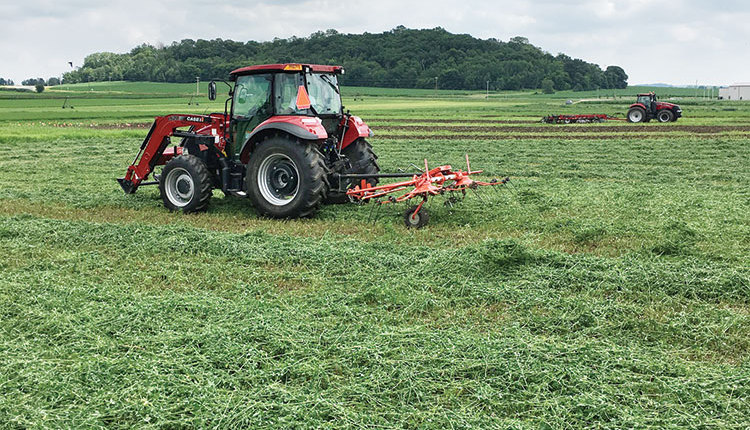

When forage harvesters told Digman they were tedding to speed the drying of alfalfa silage, he wondered if that practice would improve forage quality and if it was cost-effective.
He applied for, and received, one of the first of nine projects funded by the Alfalfa Checkoff. That funding also allowed Digman to get a UWRF student involved in agricultural research. He selected Lindsey Murry to assist on his project.
Murry coordinated the study comparing the quality of tedded and untedded alfalfa on three cuttings in May, June, and July 2018, at the UWRF Mann Valley Farm. Samples were analyzed for quality using near-infrared reflectance spectroscopy. Levels of crude protein, neutral detergent fiber (NDF), water soluble carbohydrates (WSC), ash, and total digestible nutrients (TDN) were measured.
“In the end, we saw pretty minor differences in all of quality parameters,” Digman said. “There were some advantages to tedding, but I would say the advantages we measured wouldn’t offset the cost of the (extra) field operation from a quality standpoint.”
Averaged across the three cuttings, tedding did speed drying to a moisture content of 51 percent versus 62 percent for untedded alfalfa. But crude protein dropped, NDF rose slightly, and no difference in TDN was observed. Water soluble carbohydrates, which help improve fermentation and silage quality, were higher but the levels in both treatments were in an acceptable range for good forage based on previous research.
A confusing lower amount of ash was measured for tedded silage versus untedded. “We can’t prove it, but we have a guess of why that’s happening,” Digman said. “The hay that wasn’t tedded became matted down to the ground, so maybe we picked up some ash that way.”
“At this point, those under tight harvest windows can possibly justify the cost of tedding alfalfa for silage if you’re running a real tight ship and you want to speed harvest time,” Digman added.
“I worked to develop a decision tool for producers where they can model the cost of the different operations, and I think that’s the biggest takeaway from this research,” Murry said. Her spreadsheet, which can be used on Windows operating systems, allows farmers to enter their own equipment and then calculates the costs of different field operations on a per-ton, per-hour, and per-acre basis. It can be found at bit.ly/NAFACostTool.
Kevin Shinners, University of Wisconsin-Madison agricultural engineer, said alfalfa tedder research is just beginning. “Based on his (Digman’s) work, higher productivity of tedders is going to be beneficial and is spurring us to investigate different ways to ted material faster.”
Shinners and his research design team are working on a tedder that will operate at higher speeds than traditional tedders but be gentler on alfalfa plants and produce a more uniform crop mat.
Project objectives:
• Provide a learning opportunity for undergraduate agricultural engineering students in forage systems.
• Study the impact of tedding on the economics of alfalfa silage production using the USDA’s Integrated Farming Systems Model (IFSYM) and compare the results of the model to field observation.
• Determine field operating costs and efficiencies of modern tedders and summarize results into a decision tool allowing producers to determine if tedding fits into their operation.
Project results:
• Field trials showed tedding alfalfa before harvesting for silage, using tedders currently on the market, may be cost-effective for large, efficient harvesters with narrow harvest windows. The added field operation costs otherwise outweighed the small quality advantages.
• A decision-tool spreadsheet for producers was developed to determine the costs of tedding as well as other field operations.
This article appeared in the February 2019 issue of Hay & Forage Grower on pages 20 and 21.
Not a subscriber? Click to get the print magazine.
